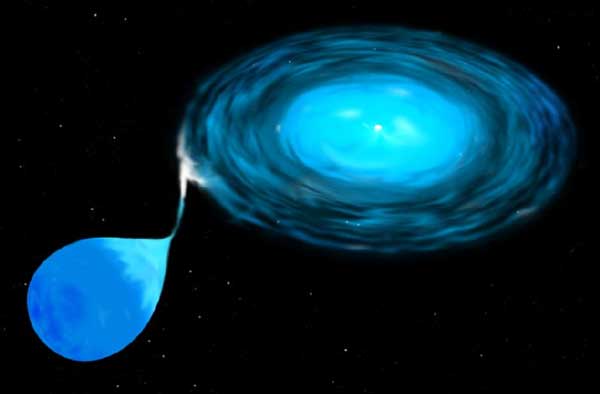- ^ Jean-Marie Hameury (2002). "VY Sculptoris stars as magnetic CVs" arxiv:astro-ph/0207084v1.
- ^ Defining Characteristics of the SW Sextantis Stars.
- ^ Ronald Downes, et. al.. A Catalog and Atlas of Cataclysmic Variables.
- ^ M Darnley et al (2005). "Classical novae from the POINT-AGAPE microlensing survey of M31 -- II. Rate and statistical characteristics of the nova population" arxiv:astro-ph/0509493.
- ^ F Senziani et al (2008). "Detectability of gamma-ray emission from classical novae with Swift/BAT" arxiv:0804.4791 [astro-ph].
Artist's conception of a cataclysmic variable system . Here gas from a blue giant star is shown being stripped away into an accretion disk around its compact binary companion. Gas in the accretion disk swirls around, heats up, and eventually falls onto the compact star. Extreme conditions frequently occur on the surface of the compact star as gas falls in, many times causing detectable X-rays, gamma-rays, or even cataclysmic novae explosions. Studying the extreme conditions in these systems tells us about the inner properties of ordinary matter around us. STScI Cataclysmic variable stars (CV) are stars which irregularly increase in brightness by a large factor, then drop back down to a quiescent state. They were initially called novae, from the Latin 'new', since ones with an outburst brightness visible to the naked eye and a quiescent brightness invisible appeared as new stars in the sky. They consist of two component stars; a white dwarf primary, and a mass transferring secondary, with an orbital period generally between about 80 and 700 minutes. The stars are so close to each other that the gravity of the white dwarf distorts the secondary, and the white dwarf accretes matter from the companion. Therefore, the secondary is often referred to as the donor star. The infalling matter, which is usually rich in hydrogen, forms in most cases an accretion disc around the white dwarf. Strong UV and X-ray emission is often seen from the accretion disc. The accretion disk may be prone to an instability leading to dwarf nova outbursts, when a portion of the disk material falls onto the white dwarf; the cataclysmic outbursts occur when the density and temperature at the bottom of the accumulated hydrogen layer rise high enough to ignite nuclear fusion reactions, which rapidly burn the hydrogen layer to helium. If the accretion process continues long enough to bring the white dwarf close to the Chandrasekhar limit, the increasing interior density can ignite runaway carbon fusion and trigger a Type Ia supernova explosion, which completely disrupts the white dwarf. Classification of cataclysmic variables Cataclysmic variables are subdivided into several smaller groups, often named after a bright prototype star characteristic of the class. In some cases the magnetic field of the white dwarf is strong enough to disrupt the inner accretion disk or even prevent disk formation altogether. Magnetic systems often show strong and variable polarization in their optical light, and are therefore sometimes called polars; these often exhibit small-amplitude brightness fluctuations at what's presumed to be the period of rotation of the white dwarf
Catalogues of cataclysmic variables There are over 1600 known CV systems [3], though more are discovered each year whilst that catalogue was frozen as of 1 February 2006. Discovery of cataclysmic variables Cataclysmic variables are among the classes of astronomical objects most commonly found by amateurs, since a cataclysmic variable in outburst is bright enough to be detectable with very modest instruments, and the only celestial objects easily confused with them are bright asteroids whose movement from night to night is clear. Around six novae are discovered each year, whilst models based on observations in other galaxies suggest that the rate of occurrence ought to be between 20 and 50 [4]; this discrepancy is due partly to obscuration by interstellar dust, and partly to a lack of observers in the southern hemisphere and to the difficulties of observing while the Sun is up and at Full Moon. Verifying that an object is a cataclysmic variable is also fairly straightforward: they are usually quite blue objects, they exhibit rapid and strong variability, and they tend to have peculiar emission lines. They emit in the ultraviolet and X-ray ranges; they are expected also to emit gamma rays, from annihilation of positrons from proton-rich nuclei produced in the fusion explosion, but this has not yet been detected [5] References
Links
Retrieved from "http://en.wikipedia.org/"
|
|
||||||||||||||||||||||||||||||||
